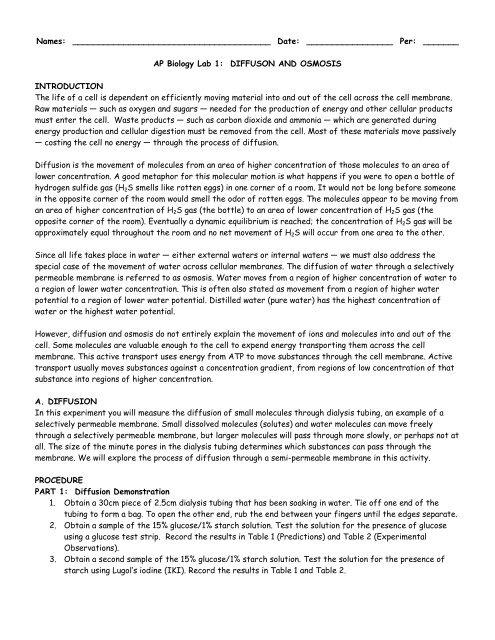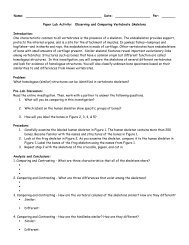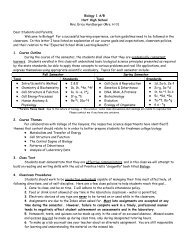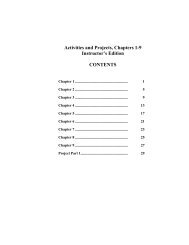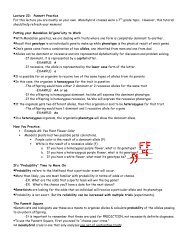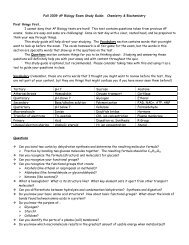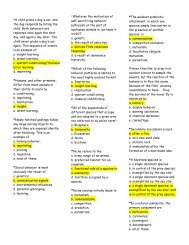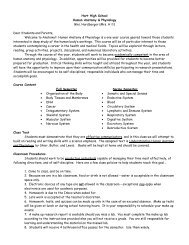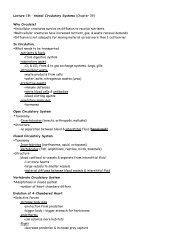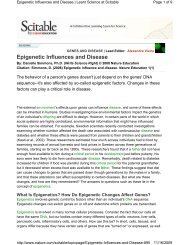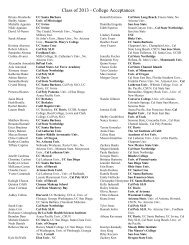AP Biology Lab 1 - Hart High School
AP Biology Lab 1 - Hart High School
AP Biology Lab 1 - Hart High School
- No tags were found...
You also want an ePaper? Increase the reach of your titles
YUMPU automatically turns print PDFs into web optimized ePapers that Google loves.
Let us now use these principles to investigate the movement in and out of plant cells using baby carrots.PROCEDUREPart 2: Osmosis <strong>Lab</strong> Group Experiment1. Prepare 1 liter of each of the following sucrose solutions: 0.0M 0.2M 0.4M 0.6M 0.8M 1.0M2. Pour 100mL of each solution into a labeled clear plastic cup.3. Obtain 24 baby carrots from your teacher.4. Determine the mass of four carrots together. If there is any wait time for a balance, keep your potatocores in a covered beaker until it is your turn. Record the mass of each set of carrots in Table 3.5. Put a set of four cores into the appropriate beaker of sucrose solution. Cover each beaker with plasticwrap to prevent evaporation. Let stand overnight.6. Remove the cores from each beaker, blot them gently on a paper towel, and determine the mass of eachset of four carrots. Record the final mass in Table 3. Calculate the percent change in mass for eachsucrose solution and record in Table 3.7. Collect and average the class data in Table 4.8. Graph both your individual results and the class average for the percentage change in mass.9. Complete the Summary Questions for this section of the lab.TABLE 3: CARROT INDIVIDUAL DATAContents in PlasticCupInitial Carrot Mass Final Carrot Mass Mass Difference Percent Change inMass0.0 M SucroseO.2 M Sucrose0.4 M Sucrose0.6 M Sucrose0.8 M Sucrose1.0 M SucroseTABLE 4: CARROT CLASS DATAContents inPercent Change in Carrot MassPlastic Cup 1 2 3 4 5 6 7 8 9 10 Tot. Ave.0.0 M Sucrose0.2 M Sucrose0.4 M Sucrose0.6 M Sucrose0.8 M Sucrose1.0 M Sucrose
Title _______________________________________________________________________________CarrotsCarrotsB1. From the graph, determine the sucrose molar concentration equivalent to the molarity of the carrots.B2. Explain how you determined this answer.C. PLANT CELL PLASMOLYSISCells lose or gain water due to the difference in solute concentrations between the cytoplasm (the intracellularfluid) and the solution surrounding the cell (the extracellular fluid). The movement of water in and out of a cellis governed by the laws of diffusion: water flows from a region of higher water concentration to a region oflower concentration.When a cell is in a hypertonic solution, it will experience a net loss of water. A hypertonic solution contains ahigher concentration of solutes than the cell and therefore a lower concentration of water. Consequently, waterwill flow out of the cell from the region of higher water concentration to the region of lower concentration.When a cell is in a hypotonic solution, it will experience a net gain of water. A hypotonic solution contains a lowerconcentration of solutes than the cell and therefore a higher concentration of water. Consequently, water willflow into the cell from the region of higher water concentration to the region of lower concentration. When acell is in an isotonic solution, it will experience neither a net gain nor loss of water. An isotonic solution containsan equal concentration of solutes as the cell and therefore an equal concentration of water. Consequently, waterwill flow equally into and out of the cell. Plasmolysis is the shrinking of the cytoplasm of a plant cell in responseto diffusion of water out of the cell and into a hypertonic solution surrounding the cell. During plasmolysis the
cell membrane pulls away from the cell wall. In this lab exercise, you will examine this process by observing theeffects of a highly concentrated salt solution on plant cells.PROCEDUREPart 3: Plasmolysis Demonstration1. View the video ( ) shown in class. Sketch and describe the appearance of the red onion cells.2. The video will show the addition of a salt (NaCl) solution to the cells. Explain what you observe.3. The narrator of the video will explain that water is being added back to the cell. Explain what youobserve.4. Answer the Summary Questions at the end of the lab.SUMMARY QUESTIONSType your answers to these questions in complete sentences. Merge your group’s answers into 1 document andsubmit it on the lab due date. You may complete the graph on here (a grid is provided) and be sure to submitthis entire document with your lab questions.A. DIFFUSION1. Which substance(s) are entering the dialysis bag and which are leaving the bag? What experimental evidencesupports your answer?2. Explain the results you obtained by discussing concentration differences and membrane pore size.3. Although we didn’t measure it, what other molecule can we assume also moved across the membrane?4. In assessing the movement of glucose, starch and iodine across the membrane in this experiment, yougenerated qualitative data. Quantitative data use numbers to measure observed changes. How could thisexperiment be modified so that quantitative data could be collected to show that water diffused into thedialysis bag?5. Based on your observations, compare the size of each of the following molecules with the membrane poresize: glucose molecules, water molecules, IKI molecules, and starch molecules.6. What results would you expect if the experiment was set up incorrectly: a glucose and IKI solution wasplaced inside the dialysis bag and a starch and water solution was in the beaker?7. In many animals, glucose, rather than starch, is transported by the blood through the body to all cells. In thedigestive system, starches are digested by amylase to yield glucose. Based on the findings of this lab, explainwhy the digestion of starch to glucose is necessary.8. Summarize the process of diffusion.
B. OSMOSIS9. Zucchini cores placed in sucrose solutions at 27°C resulted in the following percent changes after 24 hours:Sucrose Molarity% Change in Mass0.0 M Sucrose 20%0.2 M Sucrose 10%0.4 M Sucrose -3%0.6 M Sucrose -17%0.8 M Sucrose -25%1.0 M Sucrose -30%Title _________________________________________________________________________10. From the graph, determine the sucrose molar concentration equivalent to the molarity of the zucchini cells.11. Why did you calculate percent (%) change in mass of the potato cores rather than use the change in massdirectly?C. PLANT CELL PLASMOLYSIS12. What is plasmolysis?


